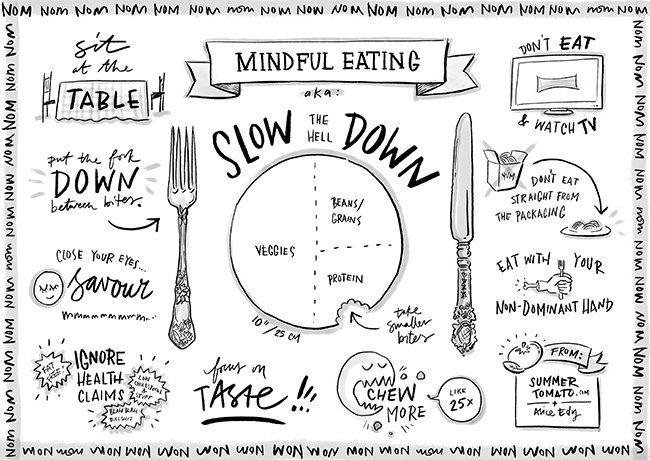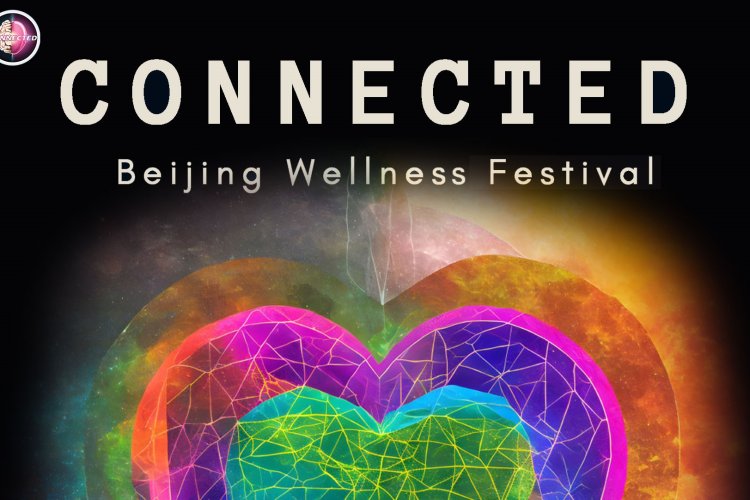Think the Shame Away: Discovering the Art of Mindful Eating
Many (dare I say most) of us are seeking to improve our relationship with food. Be it for the sake of weight loss, healthier habits, or a desire to find more pleasure in our meals, we can all relate to questioning our eating habits. Recently, emerging science from the field of mindfulness psychology has revealed an effective way to improve our relationship with food, mindful eating, a non-judgmental awareness of the complete experience of eating. It can be tempting to write this off, perhaps thinking "I don’t have time/energy/desire to do some kind of meditation while I eat," but I urge you to read on and give this a chance. This science-backed, step-by-step approach to eating is proven to positively influence our relationships with food, and is fun and interesting, to boot!
Before digging into the steps and the science, however, I’d like to share my own experience with mindful eating. Coming from a family and a culture whose cuisine is less-than-healthy, I’ve always felt my relationship with food is directly related to my relationship with health, and, as a woman, this association is naturally also intricately tied to weight and beauty. I have experimented with various diets in the past, but have never truly resonated with the mindset of denying myself certain foods, and found that any attempt to do so would only lead to the strengthening of that craving and subsequent binging. I stumbled across the concept of mindful eating in my study of mindfulness with The Mind Body Project, and decided to try it out for a week. As I applied the practice, I could feel my attachment to tastes and cravings becoming healthier and more exciting, a source of joy and thoughtfulness rather than guilt and shame.

What is Mindful Eating?
In order to understand your body’s reaction to food, you first need to listen to the body, the mind, and the world around you. As you practice this awareness, the process of eating becomes more thoughtful, more reflective, and you’ll begin to recognize the way your senses engage with your food, the way your mind associates smells and tastes with memories and triggers, and the way your environment adds or detracts from the experience of eating. There’s much to discover! You might learn that a certain food always makes you tired and that another food energizes you. Or you might realize that you only eat a particular food when you’re anxious or only overeat when you’re sad, or perhaps withdraw from food altogether when you’re stressed. When we listen, we learn, and are more able to take the actions that will help the body and mind thrive.
So, do you want to transform your relationship with food? Try these five strategies to learn how to listen to your body.
Calm the body before eating
When stress is present in the body, hormones are released that cause our digestive processes to become unreliable and inconsistent. It becomes harder to identify when the body is truly hungry, let alone knowing which foods the body needs for nourishment and which it craves for comfort. When we calm the body before eating, we allow these signals to become clearer and thus can provide precisely what we need to feel strong, healthy, and satisfied. To calm the body before each meal, take a few deep breaths, play calming music while you prepare, and take five minutes to stretch all the major muscle groups. Offer your body a bit of self-massage in the spots that need it most, and remove any stressors from your immediate vicinity (no phones at the table!).
To create a calmness around food specifically, it can also be helpful to periodically do short, food-focused mindful meditations.
Bring mindfulness to each bite
We can approach active mindfulness from several perspectives, beginning with what is going on in the body, mind, and environment whilst eating.
Consider the following during a mindful meal:
| Body | Mind | Environment |
|---|---|---|
|
Engaging the senses. Is it warm or cold? Is it savory or sweet? Is it crunchy or soft? Explore even further by trying to identify the exact flavors. Ask yourself: What herbs or spices are in this food? Does the food have any added sugar or salt? What other ingredients are in the food? |
Tune into emotions. Does eating this food evoke any emotions—for example, happiness, calm, excitement, contentment, anxiety, anger, sadness, loneliness, shame, or guilt? If so, dig a little deeper and see if you can figure out why. |
When do I eat what I eat? Take note of when and where you experience cravings. Is there any similarity in environment? Is there something in the world around you providing a cue for eating? Dig deep – where does this association come from? |
|
What is my body doing? Any tummy rumbling, sweating, tiredness, nasal congestion, tingling, goosebumps, or any other bodily sensations? Is your stomach feeling full? Does your body want to keep eating? Or are you still trying to satisfy other types of hunger? |
Associations and triggers. We may start to see ways we use food to regulate and generate certain emotions. Can you find the stories that have created these associations within your relationship to food? |
Which setting brings comfort vs distress? We know how important it is to find calm while eating. Notice in which environments you feel rushed, uncomfortable, or insecure while eating. On the flip side, notice those contexts which support positive experiences with food. |
Remember, there are no right or wrong answers. Rather, aim to bring awareness to your whole experience to better understand the habits, drives, and experiences you have in relation to food.
Pause before, during, and after
Before
Before beginning to eat, ask yourself which types of hunger you’re currently feeling (via Dr. Jan Chozen Bays, Mindful Eating):
- Eye hunger: Did you see food and then want to eat?
- Nose hunger: Did you smell food and then want to eat?
- Ear hunger: Did you hear food cooking or being eaten and then want to eat?
- Mouth hunger: Did you taste food and then want to eat more?
- Stomach hunger: Did your stomach feel empty or growl and then want to eat?
- Mind hunger: Did you realize it was a certain time of day or think that you “should” eat more of a particular kind of food and then want to eat?
- Emotional hunger: Did you feel sad, lonely, or anxious and then want to eat?
- Cellular hunger: Did you get an intuitive craving for a specific food and then want to eat?
When you really experience and begin to understand all of your hungers, you can finally learn how to satisfy them. If you can fulfill the hunger you are experiencing, you’ll achieve the type of satisfaction you seek.
During
Pause after you’ve eaten enough food until it has reached your stomach and the digestive process has begun. During this pause, listen to your body to see if you can experience how it’s receiving the food. Pay attention to things like tummy rumbling, sweating, tiredness, nasal congestion, tingling, goosebumps, or any other bodily sensations. Notice which types of hunger you are still experiencing, and which have changed or gone away: in which ways are you satisfied and in which ways are you still in need?
After
Once you decide to stop eating, take a moment to reflect on the entire experience. Start by asking yourself if each of the eight types of hunger (eye, nose, ear, mouth, stomach, mind, emotional, and cellular) have been satisfied. Make a mental note or scribble on a piece of paper the hungers that were not satisfied by this meal.
Spend an extra few minutes reflecting on each of the hungers that were not satisfied. Ask your body what it would need to satisfy each hunger. You may not get all the answers you’re looking for on the first try, but once you start listening to your body regularly, you’ll likely start to notice trends. And as you gather these insights, it becomes easier to eat in ways that are more satisfying and filling.
Explore food-related associations and triggers
Given that we all must eat regularly, and that we also live in a society with harsh expectations around health, beauty, and well-being, it is not at all uncommon to develop associations and triggers around food.
Shira Lenchewski, author of The Food Therapist, suggests that there are five dysfunctional habits that many of us have around food:
- Having trust issues (you just can’t stop yourself from eating)
- Being a “pleaser” (you cave in to other people’s food choices)
- Fearing the mundane (you think eating healthy would be way too boring)
- Craving control (you beat yourself up for tiny diet “mistakes”)
- Having a hot-and-cold pattern (you yo-yo diet and quickly go from “all in” to “all out”)
Do any of those feel familiar? By becoming aware of our associations with food, we can better explore the reasons behind them, thereby better knowing ourselves and consequently can effectively strategize how to remove or transform them. For example, if you crave control, you might work on acceptance so that you’re not ashamed or disappointed when your diet is imperfect. If you’re a pleaser, you could practice knowing and pursuing the food that is best for you. Or if you fear the mundane, you could get a new cookbook or try a new restaurant.
Turn addictions into indulgences
Food addictions – especially to sugar, caffeine, and alcohol but sometimes also to dairy, carbs, and chocolate – have a voice and a mind of their own and can drown out the voice of your body trying to communicate your true hunger, nutrient deficiencies, and food intolerances. When you try to listen to your body, you may simply hear, “Candy, chips, coffee, booze!”
Once you remove addictive foods, you might start to crave things you never expected. This doesn’t necessarily mean removing them cold-turkey and forever (although it could): more importantly, you reduce your levels of intake to a point where your body no longer screams for these foods and instead recognizes that they are a now-and-then sort of treat. When I cut down on addictive foods, I noticed an intense craving for millet, chickpeas, and tofu (foods all high in protein). I immediately understood that these cravings were a message from the body – “eat more protein!” – and satisfying that deficiency was a truly awesome moment: the chickpeas made my mouth water before even reaching my tongue!
What it all means
Listening to how your body reacts to food requires some effort – time, curiosity, willingness to be aware, open, and accepting. As with all exercises, this practice comes easier and more natural as time passes and eventually becomes ritualistic. With that in mind, practice mindful eating when you can, and see if you can take just one insight from each mindful meal. In time, hopefully, you’ll discover what nourishes your mind, body, and soul.
READ: A Bowl of Hainanese Chicken Rice That Will Take You Back in Time
Images: Victoria Shes on Unsplash, Darya Rose @summertomato
Related stories :
Comments
New comments are displayed first.Comments
![]() CatPilgrim
Submitted by Guest on Wed, 10/16/2019 - 10:56 Permalink
CatPilgrim
Submitted by Guest on Wed, 10/16/2019 - 10:56 Permalink
Re: Think the Shame Away: Discovering the Art of Mindful Eating
G-Zeus. This piece is half the length of the Dao De Jing about...what? One's attitude to food. Eat yo' dinner girl, it's getting cold. What next can we look forward to? A lengthy musing about Mindful Defecation?
Overweight can on occasion be genuinely attractive; self-absorption, never.
Wow. Sexism, body-shaming, condescending tone, and ignorance all rolled into one comment.
What a prick
Validate your mobile phone number to post comments.







